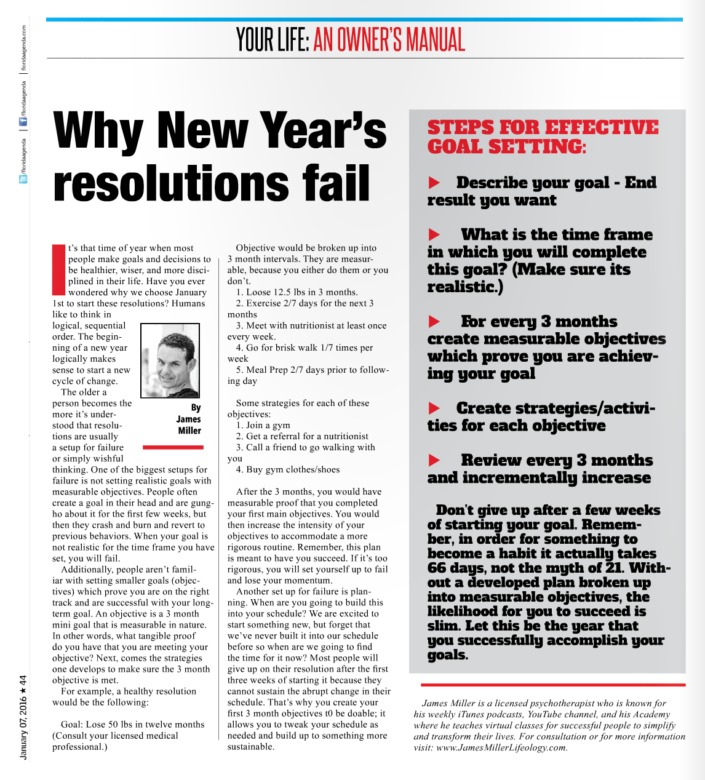It’s that time of year when most people make goals and decisions to be healthier, wiser, and more disciplined in their life. Have you ever wondered why we choose January 1st to start these resolutions? Humans like to think in logical, sequential order. The beginning of a new year logically makes sense to start a new cycle of change.
The older a person becomes the more it’s understood that resolutions are usually a setup for failure or simply wishful thinking. One of the biggest setups for failure is not setting realistic goals with measurable objectives. People often create a goal in their head and are gung-ho about it for the first few weeks, but then they crash and burn and revert to previous behaviors. When your goal is not realistic for the time frame you have set you will fail.
Additionally, people aren’t familiar with setting smaller goals (objectives) which prove you are on the right track and are successful with your long-term goal. An objective is a 3 month mini goal that is measurable in nature. In other words, what tangible proof do you have that you are meeting your objective? Next, comes the strategies one develops to make sure the 3 month objective is met.
For example, a healthy resolution would be the following:
Goal: Lose 50 lbs in twelve months (Consult your licensed medical professional.)
Objective would be broken up into 3 month intervals. They are measurable because you either do them or you don’t.
1. Loose 12.5 lbs in 3 months.
2. Exercise 2/7 days for the next 3 months
3. Meet with nutritionist at least once every week.
4. Go for brisk walk 1/7 times per week
5. Meal Prep 2/7 days prior to following day
Some strategies for each of these objectives:
1. Join a gym
2. Get a referral for a nutritionist
3. Call a friend to go walking with you
4. Buy gym clothes/shoes
After the 3 months you would have measurable proof that you completed your first main objectives. You would then increase the intensity of your objectives to accommodate a more rigorous routine. Remember, this plan is meant to have you succeed. If it’s too rigorous you will set yourself up to fail and lose your momentum.
Another set up for failure is planning. When are you going to build this into your schedule? We are excited to start something new, but forget that we’ve never built it into our schedule before so when are we going to find the time for it now? Most people will give up on their resolution after the first three weeks of starting it because they cannot sustain the abrupt change in their schedule. That’s why you create your first 3 month objectives t0 be doable; it allows you to tweak your schedule as needed and build up to something more sustainable.
Steps for effective goal setting:
1. Describe your goal – End result you want
2. What is the time frame in which you will complete this goal? (Make sure its realistic.)
3. For every 3 months create measurable objectives which prove you are achieving your goal
4. Create strategies/activities for each objective
5. Review every 3 months and incrementally increase
Don’t give up after a few weeks of starting your goal. Remember, in order for something to become a habit it actually takes 66 days, not the myth of 21. Without a developed plan broken up into measurable objectives the likelihood for you to succeed is slim. Let this be the year you successfully accomplish your goals.
James Miller is a licensed psychotherapist who is known for his weekly iTunes podcasts, YouTube channel, and his Academy where he teaches virtual classes for successful people to simplify and transform their lives. For consultation or for more information visit: www.JamesMillerLIFEOLOGY.com.


 We all get overwhelmed and sometimes don’t know what to do. LIFE LESSONS is your new “go-to” book to help you navigate life.
We all get overwhelmed and sometimes don’t know what to do. LIFE LESSONS is your new “go-to” book to help you navigate life.